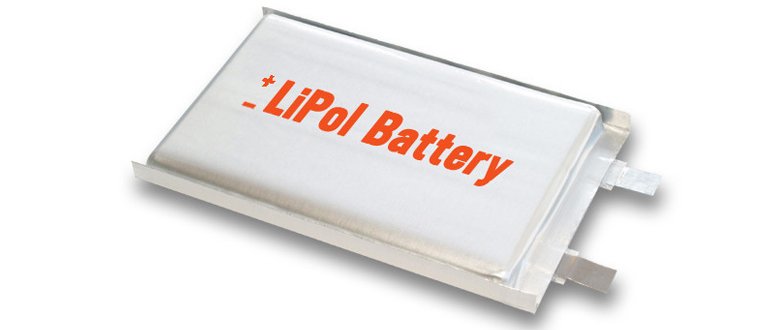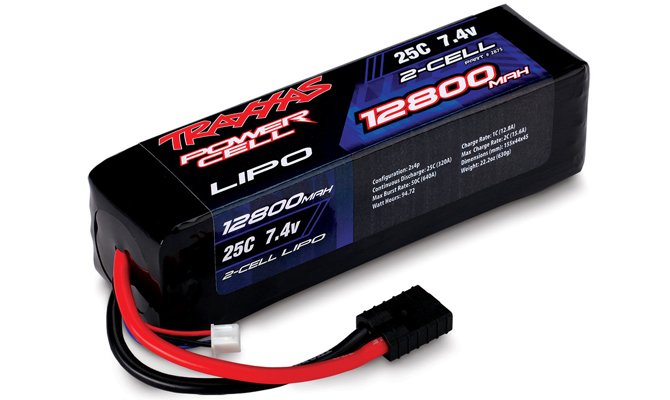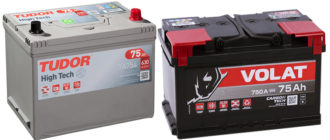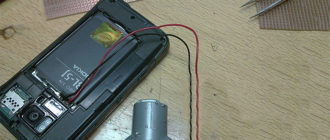The constant development of technology favorably affects many aspects of people's lives. The need to have high-performance power sources with a good balance of safety, cost and performance has led to the creation of lithium-polymer elements.
Content
- What is a lithium polymer battery
- How is the production of lithium polymer batteries
- The principle of operation and the device lithium polymer battery
- Lithium Polymer Battery: Pros and Cons
- Where are Li Pol batteries used?
- Li Pol Battery Usage Guidelines
- How to store lithium polymer batteries
- Disposal of lithium polymer batteries
What is a lithium polymer battery
Li polymer batteries are galvanic power supplies that use lithium-saturated polymer materials as the electrolyte.
Lithium-polymer technology has become a new stage in the development of lithium-ion power sources, which has reduced the cost of their production and allowed the creation of miniature and flexible batteries.
When buying and using such batteries, you must understand the markings applied to them, which has the following features:
- battery capacity is indicated in mAh;
- the number next to the English letter S in the marking indicates the number of individual elements (cans) in the battery, each of which has a nominal voltage of 3.7 volts and a maximum of 4.2 volts;
- the number next to the letter C indicates the maximum current output in units of C. The maximum discharge current in milliamperes per hour is equal to the battery capacity multiplied by this value;
- the number next to the letter P indicates the number of cans connected in parallel. When using one can, this value is usually not indicated.
Thus, the designation 2600 mAh 3S 20C denotes a 2600 mAh Li-polymer battery with a nominal voltage of 11.1 volts (maximum 12.6 volts), with three banks connected in series and a permissible discharge current of 52 amperes (2600x20 = 52000 mA).
How is the production of lithium polymer batteries
In the manufacture of Li-polymer power supplies, this technology is used:
- The suspension is applied in a controlled manner with the active materials of the cathode and anode (two different processes) on the surface of aluminum or copper foil, which acts as a current collector.
- The foil with the applied material is dried, cut into elements of the required size and shape.
- The preparation of a polymer electrolyte separator is carried out, which is then placed between the layers of foil with the active materials of the cathode and anode.
- The multilayer battery is being assembled, sealed and dried.
- When using a polymer separator that requires inclusions of gel electrolyte, it is filled with the right amount of electrolyte liquid.
- The installation of contact pads, packaging in a protective shell and trimming its protruding parts.
- External battery terminals are installed.
- A charge / discharge control cycle and testing are performed.
- Culling, sorting by capacity and drawing the appropriate designations are carried out.
- If necessary, wires are soldered to the battery terminals.
- Quality control is carried out, the packaging of the battery cells in the housing, which is applied the necessary marking and packaging.
The principle of operation and the device lithium polymer battery
The principle of operation of Li pol batteries is based on the use of a semiconductor effect in polymer substances with inclusions of electrolyte ions. The addition of electrolyte to polymers causes an increase in their ionic conductivity while maintaining the insulating properties of the plastic with respect to electrons.
The electromotive force in relation to lithium ions occurs as a result of a reversible chemical reaction between the anode (plus) of carbon (usually graphite) and the cathode (minus) of cobalt, vanadium oxide or manganese, placed in a polymer electrolyte with lithium salts.
There are three types of polymer electrolytes:
- Completely dry polymer electrolytes, which are plastic with the addition of lithium salts, give a low current at room temperature, insufficient for most modern devices and are more expensive than ordinary lithium-ion batteries.
- Gel-like polymer electrolytes, which are dry polymer electrolytes interspersed with plasticizers-solvents, have acceptable indicators of capacity, current strength and cost and are most often used in practice.
- Non-aqueous solutions of lithium salts distributed in a microporous polymer matrix by absorption.
Massively sold Li Po batteries are actually hybrids that combine not only pure dry polymer electrolyte, but also a small amount of gel electrolyte, which also contains lithium-ion sources.
The addition of inclusions of gel electrolyte in a solid polymer electrolyte increases its ionic conductivity and electrical characteristics, in particular, the operating current increases to the value necessary for most modern small-sized devices.
Lithium Polymer Battery: Pros and Cons
Li-polymer power supplies have the following advantages:
- high energy density in relation to their mass, 4-5 times higher than that of nickel-cadmium batteries, and 3-4 times higher than that of nickel-metal hydride power sources;
- low self-discharge current and high current efficiency;
- the ability to create flexible and very thin products;
- lack of memory effect;
- maintaining voltage within acceptable limits during a working discharge;
- a wide range of permissible temperatures during operation (from -20 to +40 degrees).
Lithium polymer batteries have some disadvantages:
- fire hazard in case of overcharging / overheating. These batteries require the use of protective electronics, which monitors the charging current and temperature, as well as a special charging algorithm;
- the aging effect, leading to a decrease in capacity during long-term storage and operation (it is believed that the battery loses up to 20% of capacity for each year);
- failure during deep discharge (below 3 volts);
- fear of overheating above 60 degrees and overcharging above 4.2 volts (with a voltage above 4.5 volts, an explosion is possible);
- the use of a thin shell (usually in the form of foil) in some of these batteries reduces the cost of Li Pol cells, but at the same time reduces their strength.
Where are Li Pol batteries used?
This type of power source due to its light weight and high power is widely used to provide power to small and large-sized devices, including:
- mobile phones and smartphones;
- radio-controlled models, quadrocopters, microplanes;
- power tool;
- digital technology, ultrabooks;
- electric cars.
Li Pol Battery Usage Guidelines
To ensure the necessary level of safety and extend the life of serviceable batteries, you must adhere to the following rules:
- in the presence of damage, swelling of the batteries, they cannot be used, but must be disposed of;
- the batteries need to be charged with a quality charger under supervision, preventing the battery from overheating. If during charging there is a burning smell, bloating, ignition, you must immediately stop it and disconnect the battery from the charger;
- it is better to charge on a non-combustible surface, for example on a ceramic tile or porcelain plate, after fully charging the power source, it is better to let it cool and only then start using it;
- a discharge below 3 volts, overheating or overcooling, which reduce the capacity and the total number of charge-discharge cycles, must not be allowed;
- the longest life of LiPo cells is achieved while maintaining their charge level at 45%;
- The best charging mode for LiPo batteries is provided by Sony chargers for approximately three hours. It takes place in three stages:
- First, for about one hour, charging is performed up to 70% with direct current of 0.5-1 from the current output of the battery to a voltage of 4.2 volts;
- Recharging with a duration of 1 hour to 90% with a voltage of not more than 4.2 volts with a gradually decreasing current (up to about 0.2 from current output);
- At the third stage, charging is performed over an hour to 100% with a small constantly decreasing current.
Cheap chargers end the charge in the first stage, upon reaching a voltage of 4.2 v, so the battery does not gain its full capacity.
- Avoid shock to the battery, short circuits or discharge by very high currents, recharging above 4.2 volts per cell battery element - all these causes can cause a fire;
- if composite batteries of several Li Pol cells are used, it is better to charge them separately, or use a special equalizing charge with balancing for each cell. The principle of operation of such a device is to stop the charge of individual elements when they reach a voltage of about 4.17 volts;
- Before putting new batteries into operation, it is better to calibrate them by double full charge and discharge.
In some Li Pol batteries, a discharge lower than 2.5 volts can lead to metallization of lithium, which leads to the creation of conductive bridges inside the battery and short circuit. When charging such a battery, uncontrolled heating occurs, which can lead to the explosion of such a power source. Therefore, batteries in which the voltage has dropped below a critical level of 3 volts are better not to use, and if the voltage drops to 2.5 volts and below, they must be disposed of.
How to store lithium polymer batteries
It is desirable to store charged LiPo batteries in protective cases at room temperature while charging at the level of 3.6-3.8 volts.
Before storing LiPo cells, it is recommended that they be charged up to 40-50%, disconnected from the devices that they power and periodically, at least once every six months, check the charge level.
Disposal of lithium polymer batteries
Disposal of LiPo power supplies is of particular relevance due to their high fire hazard. They are less toxic than nickel-cadmium batteries, but still contain substances that are harmful to the environment.
In order to completely and safely dispose of Li-polymer batteries, the following requirements must be observed:
- Discharged batteries are disposed of in plastic containers with water-salt solution (about half a glass of salt per 1 liter of water) for about 2 weeks (until gas production stops) in a non-residential building. After that, they can be thrown away with ordinary garbage;
- Before disposal, the batteries must be discharged to at least one volt (this can be done with a light bulb as a load);
- if the battery case is damaged, then it does not need to be discharged, but it must be disposed of in a water-salt solution;
- if the discharge is produced by a current more than permissible, connected with the value of the maximum current output C, then the battery should be in a bucket of sand or in another place with protection against fire;
- Mechanical destruction of batteries unprocessed in saline is not allowed, which could result in fire. Especially dangerous in this regard are batteries with a cobalt cathode.












